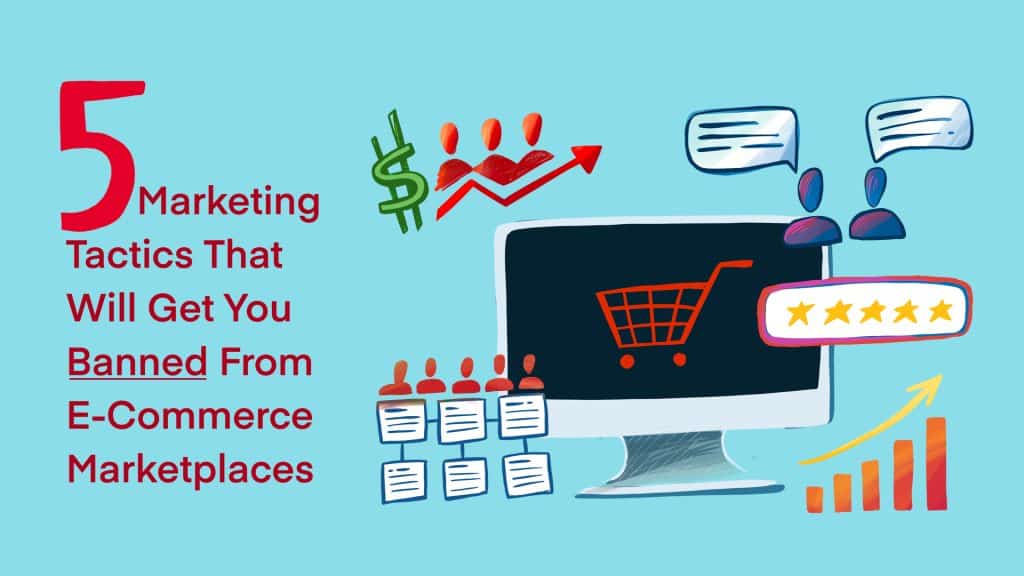
The ultimate goal of a third-party ecommerce marketplace is to match customers with the products they want and need. A complex series of algorithms are working behind the scenes to make this happen.
When sellers do things to manipulate marketplace algorithms, it interrupts the marketplace’s ability to maximize sales and satisfy customers. As such, it is common practice for marketplaces to outline specific prohibited activities in their Terms of Service (ToS) documentation to keep everything fair and honest.
Break a marketplace’s rules, and you risk getting suspended or banned from the platform—something many unfortunate ecommerce businesses have found out the hard way. Don’t give in to the temptation.
Violating Marketplace Terms of Service (ToS) is Risky Business
Outlawing a practice is one thing, but it holds little weight without enforcement. Many of the manipulative ecommerce tactics outlined in this article are quite commonplace. Today’s ecommerce environment is more competitive than ever, and some sellers are willing to play fast and loose with the rules to gain even the slightest edge.
The sheer size of the ecommerce industry makes it nearly impossible to suss out all the bad actors. This leads some merchants to risk gambling around the ToS to compete. However, the risks associated with noncompliance are real. Losing access to third-party marketplace customers—even temporarily—can severely reduce profitability and hinder your ability to scale.
In May 2021, Amazon carried out a sweeping ban on a series of brands that violated their ToS—specifically for manipulating reviews. It wasn’t just small up-and-comers trying to build their credibility; big, high-ranking consumer electronics brands Aukey and Mpower were included in the ban wave. The move gained headlines as Amazon wiped out some of the largest international private-label sellers on their marketplace.
Earlier this year, Amazon India carried out a similar suspension wave for over 2,000 sellers it deemed engaging in “deceptive, fraudulent, or illegal activity.” In addition to losing the ability to continue selling on the site, sellers lost access to their pending disbursements and could not sell off their FBA inventory while Amazon sorted out their violations.
Walmart, eBay, and other third-party marketplaces have performed similar stings to clear out ToS violators. In the end, the goal of these regulations and enforcement efforts is to create a fairer playing field for merchants and a more positive overall experience for shoppers.
The lesson is simple: When selling on a third-party marketplace, you must abide by its rules.
Some of the Most Prohibited Marketing Tactics to Avoid Include:
1. Bribing Customers for Positive Reviews and Feedback
Customer feedback and product ratings are two of the most important sources of information customers use when making purchasing decisions online. Many online shoppers report using product reviews to help inform them about the products they buy. As such, it should be no surprise that marketplaces like Amazon and Walmart would want to protect the integrity of these metrics.
In 2019, Amazon spent over $500 million and employed over 8,000 people to target fraud and misinformation on its marketplace. There are many ways unscrupulous sellers have tried to manipulate how customers rate their products and brands.
Two of the most common incentivized review schemes are:
Thank You Gifts
Sellers include instructions for customers to receive gifts in exchange for positive reviews. These gifts can include things like discount codes, vouchers for additional products, or even Amazon gift cards.
To claim these ‘gifts,’ customers are often asked to take a screenshot of their review and order number to verify that it has been posted on the marketplace. These tactics are clearly against the rules, but customers receiving free bonuses are unlikely to file formal complaints.
Soliciting Reviews from Free Products
Many marketplaces allow sellers to offer free products to customers for review purposes. It can be a great way to increase the visibility of a new product or brand. However, marketplaces usually flag reviews of free products and identify them as such so that future customers have a fair warning that the reviewers did not pay for the merchandise they are commenting on.
Sellers who circumvent these processes make it impossible for shoppers to know that a review may be from a customer who did not have to pay for the product they are praising. Amazon’s latest ban wave is a public display of how seriously it takes product reviews and feedback.
There are certainly sellers who will continue to use these tactics, but the risk isn’t worth it. The consequences of losing access to millions of customers can devastate your brand’s integrity and bottom line.
2. Manipulating Your Sales Rank with Illegitimate Sales
Your sales numbers on Amazon and most ecommerce marketplaces are not a forward-facing metric but influence your search results rank. The more a product sells, the higher the search engine results pages (SERPS) it climbs.
Some merchants have attempted to game this system by purchasing and shipping products to unsuspecting recipients. An actual address receives the orders and, thus, appears to be fulfilled legitimate purchases. The recipients are usually unaware of how or why they have received the free products but typically either accept them (the packages were addressed to them, after all) or discard them.
Sellers usually respond to this type of scam by posting their own reviews for the ‘fulfilled’ orders. In any event, these orders produce deceptive metrics that violate the ToS of nearly every ecommerce marketplace.

3. Paying for Traffic
Another way marketplaces determine where products rank in customer searches is based on how much activity a listing generates. This has led sellers to employ deceptive practices like pay-for-click services and automated web bots to try and boost their product visibility.
This is a common practice used to boost website search engine rankings. Thus, it should be little surprise that similar tactics have emerged in ecommerce marketplaces. However, just like major search engines constantly adjust their algorithms to try to detect unfair or suspect activity, major marketplaces are doing the same.
There are still those using these illicit strategies to boost listing visibility, but they are becoming less viable as marketplaces become better at identifying fake listing traffic. Successful or not, get caught paying for listing views, and your account will most certainly be suspended.
4. Direct Customer Contact
Amazon’s Seller Code of Conduct clearly states: “You may not send unsolicited or inappropriate messages. All communications to customers must be sent through Buyer-Seller Messaging and be necessary for fulfilling the order or providing customer services. Marketing communications are prohibited.”
Simply put, Amazon requires all communication you have with your customers to be handled through Amazon’s servers. This creates a complete paper trail of every interaction between buyers and sellers. Should an issue arise or an A-Z complaint be filed, this should theoretically make it quicker and easier to resolve disputes.
This control over communication also reaffirms that Amazon (or other marketplaces with similar communication rules) is in charge. As much as a marketplace wants to protect the integrity of the online shopping experience, there are also ulterior motives.
If sellers can open direct, back-channel conversations with Amazon customers, they could potentially poach those customers for future business outside the marketplace—leaving the marketplace without their cut. In the end, merchants selling on sites like Amazon must be comfortable with the fact that marketplace customers belong to the marketplace, not the marketplace sellers.
To comply with the ToS, every communication must remain in plain view and above board. Any attempt to circumvent this rule could result in suspension or ban from Amazon’s platform.
5. Participating in Complex Ecommerce Review Schemes
All of the above marketing tactics are used to try to boost sales while also circumventing marketplace policies. Sometimes, self-proclaimed ‘ecommerce marketing companies’ offer sales-boosting packages that combine these illegal tactics. In one of the latest Amazon fraudulent review schemes, a network of over 200,000 individuals shared addresses, contact information, and payment addresses to complete fake orders and generate fake positive feedback.
Customers would make Amazon purchases from participating sellers and then have their costs heavily discounted or completely reimbursed once positive reviews were verified. In some cases, the participating customers could keep the reviewed product and receive a cash bonus for reimbursed costs.
What made this scheme both possible and so hard to detect was off-marketplace communication between sellers and customers. Third-party channels like WhatsApp and PayPal meant that the conversations brokering the arrangements and the reimbursement payments to customers were all done outside of Amazon’s view. In the end, the scheme was exposed, and many accounts were immediately removed from Amazon’s marketplace.
This is not a new concept. Pay-for-review companies pop up all of the time on social media platforms like Facebook and gig economy sites like Upwork and Fiverr. The thing to know is that if they are this easy to find, Amazon can and will eventually find them, too.
Establishing Your Own First-Party Sales Channel Can Give You an Edge Over Marketplace Sellers
The fact that marketplaces like Amazon and eBay take listing integrity seriously should provide some comfort for honest sellers. That said, the same ToS designed to protect merchants and customers can sometimes interfere with legitimate efforts to build a brand and promote your business.
This is why operating a first-party sales website is critical to an omnichannel ecommerce strategy. For one thing, there is no ban on how you opt to build customer loyalty through your own sales channel. You can establish direct consumer contact, offer marketing promotions, and cultivate a brand relationship in your chosen ways.
While you can’t divert an Amazon customer to your storefront, including a web address in your product documentation can help increase the odds that repeat customers will seek you out directly. On your website storefront, you can solicit reviews and testimonials for your products.
What’s more, you can share them as you see fit—feature them on your website, share them on social media, and include them across your product marketing efforts. As long as you abide by consumer protection regulations like CCPA and GDPR and stay within FTC and IRS guidelines, you can run your ecommerce business as you wish.
The Descartes Sellercloud omnichannel ecommerce growth platform is perfectly suited to help you develop and scale your ecommerce brand across both third-party marketplaces and first-party channels. Our integrations with Amazon, Walmart, and dozens of other channels are designed to help you remain compliant with each marketplace’s ToS while also allowing you to manage every aspect of your orders from a single, convenient interface.
Our integrations with storefronts, shopping carts, 3PL providers, shipping partners, and more help you optimize your order fulfillment and customer relations workflows across first- and third-party channels.
For more on how Descartes Sellercloud can help you build your ecommerce brand the right way, contact us directly for a free demo.




